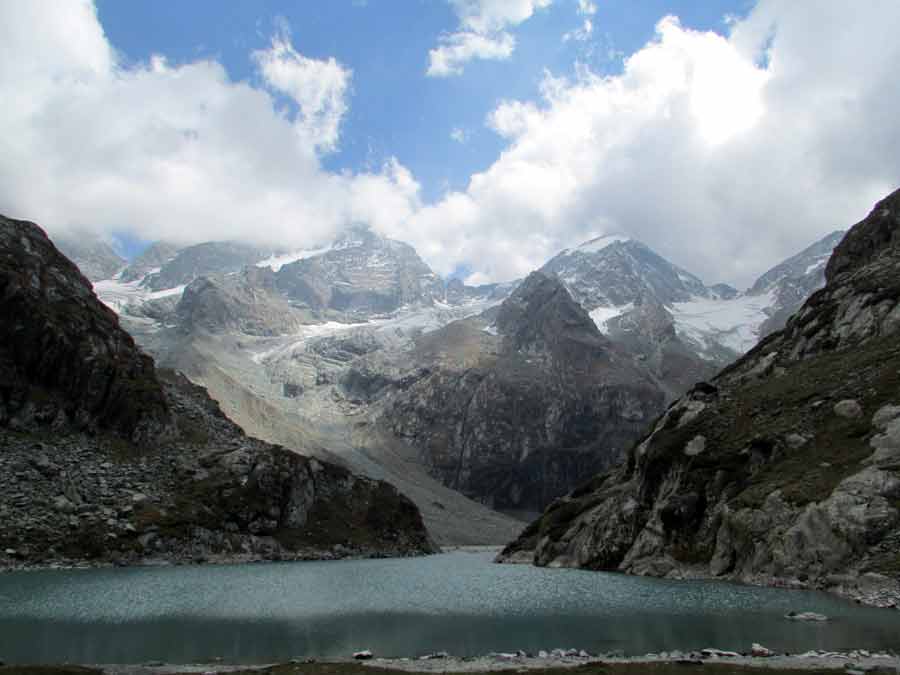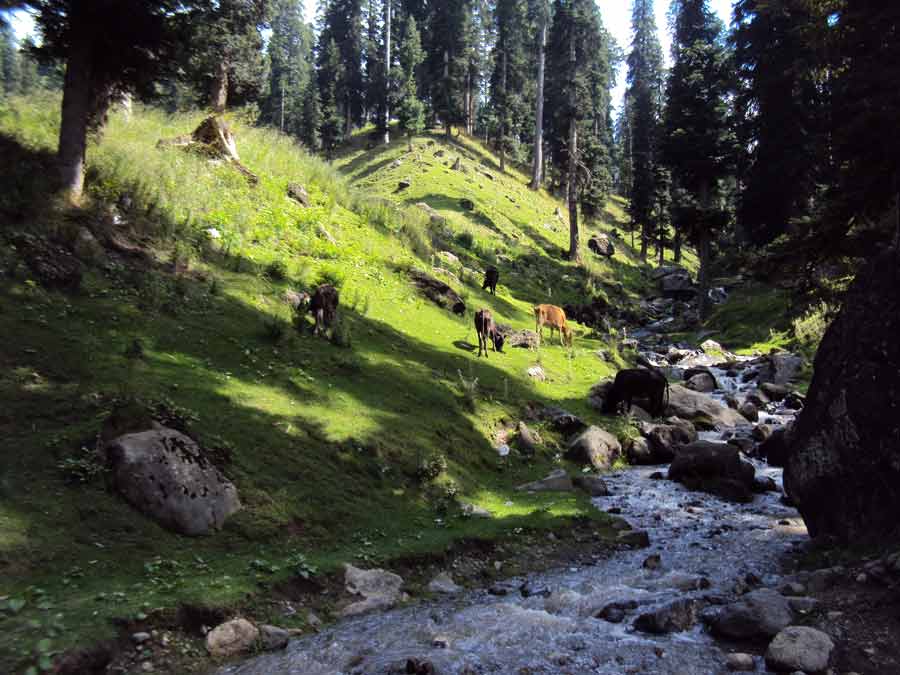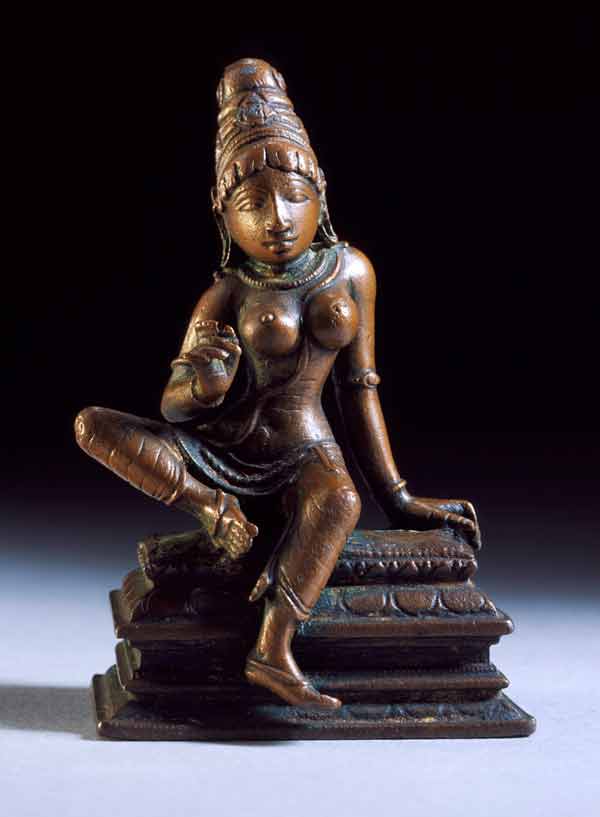
Tulian Lake
Lal-Ded is a rebel saint, a revolutionary mystic of the 14th century Kashmir. We know her only through her verses called 'Vak'; that have come
down to us through folk tradition of Kashmir. To my mind to describe Lal-Ded as a poet is a misnomer, notwithstanding the fact that her Vak are the
specimen of best poetry. In no way can she be called a poet in the modern sense of the term. Lala-vak is not primarily poetry nor is it
mere learned discourse. It is a discourse for the practical purpose of sanctifying and divinizing human nature. For Lal-Ded herself her Vak is the mantra
and worship of the lord as she herself proclaims:
whatever work I did became worship of the lord
whatever word I uttered became mantra
what this body of mine experienced became
the sadhana of saiva tantra.
Illumining my path to parma shiva[i]
Lal-Vak
forms the foundation not only of the contemporary Kashmiri literature but also of Kashmiri culture as a whole. In the ancient and the medieval period
Kashmir produced great thinkers and spiritual practitioners. But all their works are in Sanskrit. After the advent of Islam in Kashmir around the 11 th century AD, Kashmiris gradually lost their hold on the language (Sanskrit) due to various political, social, religious, and linguistic
reasons; and whatever intellectual heritage their predecessors had bequeathed, became inaccessible to them. With the passage of time a deficit emerged
between pre-Islamic Kashmir and Islamic Kashmir. Lal-Ded is the most significant historical bridge that connects the two shores of this gulf very
effectively. She was the product of the spiritual creed that had been evolving in Kashmir for centuries and her immediate predecessors were saints and
scholars like Vasugupta Rishi, Acharaya Somanand, Acharaya Utpal Dev and Acharaya Abhinavagupta. Her immediate successor and a great saint and scholar in
his own right, Nund Rishi the founder of Muslim Rishi order in Kashmir has this to say about Lal-Ded:
It was Lalla of Padmanpur,
Who drank in long draughst, nectar Divine.
She was the Divine Manifestation for us,
May thou Lord bestow a similar boon upon me[ii].

Srinagar - Pahalgam views
Lal-Vak
was not written down during her life time. It was because of her power to impact her listeners that people heard her and formed her sayings into chants and
mantras which continue to be sung even today. She revolted against all the oppressive structures that stifle and kill the human spirit and critically
interrogated practices of inequality and injustice that were current during the times. Lal-Vak is not only a continuation of the tradition; it is
also simultaneously a break or rebellion against the tradition. Her rebellion was unprecedented. She challenged the validity of all the socio-political and
religious structures, and was deadly against maintaining the status quo, thus she was perceived as a threat to the established social order. To neutralise
the impact of this rebellion, the elite of the times, the custodians of the tradition declared her to be mad and insane, it is because of these
circumstances that we don’t find her mention in any of the historical accounts written in Sanskrit during and after her times.
Lal-ded rebelled against the educated elite of Sanskrit academia who were the custodians of knowledge and tradition. She articulated the spiritual path and
message she had inherited; in Kashmiri language which was the language of the man in the street. By doing so, she made it available to all the people
irrespective of caste, creed, colour, sex, religion or region. It was no more a preserve of the Sanskrit academy. This act on the part of Lal-ded - to make
Kashmiri language the vehicle for spreading her message of universal brotherhood through her outpourings- was probably a part of the Divine Mission which
she had to fulfil and in recognition of which the great saint Nunda-Rishi calls her, ‘the Divine Manifestation for us.’ This act remains the greatest
revolutionary act in the cultural history of Kashmir and makes her the undisputed founder not only of the contemporary Kashmiri literature but also of the
contemporary Kashmiri culture.
Discrediting the large sections of the tantric lore Lal-Ded rejects wholly the ritualistic aspect of the śaivistic spiritual discipline. This
rejection is articulated and expressed with great force in her Vak. She denigrates the ceremonial piety, and to her most of these rituals are devoid of any
spiritual merit and only an uncultivated person will engage in such barren and fruitless activities .She herself had no possessions, not even a shelter but
in her ‘homeless wisdom’ articulated in a language that provides no lulling abodes of thought she tried to dismantle the deeply ingrained hereditary
patterns of thought and action. She had her own revolutionary views regarding the rituals like, idol worship, animal sacrifice, fasting, visiting sacred
places and reading sacred books. In the light of her own intense spiritual experiences, she re-evaluates these rituals and comments:
“The idol is but stone
The Temple is but stone,
From top to bottom, all is but stone
Whom will you worship, O stubborn Pandit?”
“It covers your shame,
Saves you from cold,
Its food and drink, mere water and grass
Who counselled you, O Brahmin,
To slaughter a living sheep as a sacrifice
Unto a lifeless stone?”
“O fool, right action does not lie
In fasting and other ceremonial rites
O fool right action does not lie
In providing for bodily comfort and ease
In contemplation of the self alone is right action and right council for you."
“The pilgrim sanyasin goes from shrine to shrine,
Seeking to meet Him
Who abides within herself.
Knowing the truth, O soul, be not misled;
It is distance that makes the turf look green”
“Some leave their home, some the hermitage
But the restless mind knows no rest.
Then watch your breath day and night,
And stay where you are”
“I have worn out my plate and tongue reading the holy books,
But I have not learnt the practices that would please my lord.
I have worn thin fingers and thumb telling my rosary beads,
But I have not been able to dispel duality from my mind.”
“The thoughtless read the holy books
As parrots in their cages recite “Ram, Ram”
Their reading is like churning water,
Fruitless effort, ridiculous conceit.”[iii]

The Hindu Goddess Parvati @LACMA
By opposing vehemently the ritualistic aspect of Trikmat, Lalla revolted against the powerful clergy of the times who had transformed these rituals into a
means of exploitation and a tool for perpetuating their hereditary hegemony. She also revolted against the objectification of women in Saiva rituals. She
totally rejects the secondary dependent status allotted to women in these rituals and emerges and dominates the scene as a subject.
On the one hand, Lala gave a new lease of life to Kashmiri Śaivistic spiritual tradition but on the other , she demystified Śaivism by
articulating its tenets in the language of the common people and deconstructed its ideology of being a Rahasya Sampradaya (a secret sect) by making all the
Upayas (means of realization) available to all those interested in the realization of their true identity, thus making it a viable and effective tool not
only for individual emancipation but also for social unification. There is an inbuilt dynamic reciprocal relationship between the two, and each reinforces
the other. This is the reason for total acceptance of Lal-Ded by almost all Kashmiris. With the passage of time there was a schism in the Saivistic Trikamat. On the one hand, we have the branch that maintains the rituals, although not much of the traditional rituals detailed by Abhinava Gupta
have survived the ravages of time. On the other hand, we have the ritual free Trikamat of Lal-Ded which is a syncretic tradition that assimilates
not only the essence of Buddhist spirituality but also reaches out to the Sufi-Mystic tradition of Islam. In Buddhist tradition being a Bodhi-sattva
implies being full of compassion conjoined with insight into reality, realizing emptiness (shunaya) or the essence of all things. In this light we may
consider the verse by Lalla:
Realization is rare indeed, Seek not afar, it is near, by you
First slay desire, then still the mind, giving up vain imaginings
Then meditate on self within and lo! The void merges in the void
Or this one:
Let go the sacred tantra rites
Only the mantra sound remains
And when the mantra sound departs
Only the chitta is left behind
Then lo! The chitta itself is gone
And there is nothing left behind
The void merges in the void[iv]
In the true Buddhist spirit Lalla-Ded advocates the middle path as the path of liberation and we may consider the following Vᾱk in this regard:
“By pandering to your appetites and desires
You get nowhere
By penance and fasting,
You get conceit
Be moderate in food and drink
You will be moderate
Your path will surely be illuminated*”[v]
Here are some of her verses that give us some idea of the path Lal-Ded traversed:
In life I sought neither wealth nor power,
Nor ran after the pleasures of sense,
Moderate in food and drink, I lived a controlled life;
Patiently bore my lot, my pain and poverty,
And loved my god.
O fool, right action does not lie
In observing fasts and ceremonial rites
O fool, right action does not lie
In providing for bodily comfort and ease
In contemplation of the self alone
Is right action and right counsel for you
*
Compare this with the record of the Buddha’s first sermon at the Deer Park Varanasi which states:
Then the blessed one addressed the group of five religious mendicants:
“Mendicants, there are two extremes which should not be practiced by any person who has left society to find salvation. What are these extremes? On the
one hand there is a realm of desire and pursuit of pleasure which is in accord with desire – it is a base pursuit, boorish, profane, crude and without
profit. On the other hand, there is a pursuit of self-mortification which is sheer misery, as well as crude and without profit. Mendicants, Passing
through these two extremes and avoiding them both is the middle way, object of the tathagata’s perfect awakening, opening the eyes and mind, leading to
peace, to omniscience, to complete awakening, and to nirvana”
My guru gave me but one precept
“From without withdraw your gaze within
And fix it on the Inmost self."
Taking to heart this one precept,
Naked I began to dance.[vi]
These Vᾱks give us an idea of the spiritual discipline that Lal practiced and prescribed for us. Now let us see the fruit of this spiritual labour:
Thou wert absorbed in Thine Own Self,
hidden from me;
I passed whole days in seeking Thee out
But when I saw Thee in mine own Self
O joy! Then Thou and I
disported ourselves in ecstasy
I traversed the vastness of the void alone,
Leaving behind me reason and sense,
Then came upon the secret of the self;
And, all of a sudden, unexpectedly,
In mud the lotus bloomed for me.
Like a tenuous web Siva spreads Himself,
Penetrating all frames of all things,
If while alive, you cannot see Him,
How can you see Him after death?
Think deep and sift the true Self from the self.[vii]
The last two Vaks are a bold statement that absolute reality can and is to be realized in this very life. Notice the interrogative emphasis in the two
lines:
If while alive you cannot see Him,
How can you see Him after death?
And relate it to the last line of the earlier Vak which reads:
In mud the lotus bloomed for me.
Through spiritual effort one has to realize the blooming of the flower upon the dirty ground covered with litter, mud and dirt i.e. something valueless
(representing human body). One has to begin with brute matter, the lower prakrti, the manifested universe in order to realize the higher self within (the
flower) and thence to immerse in the lake of immortality (lay Ka’rmas amritsars) that is absorption in the Divine (to quote her oft repeated phrase) void
merging in the void (shunyas shunyaya millith gay). To recognize oneself is to recognize that one is essentially the vibrating light of consciousness. This
light is eternally recreating and regenerating itself through the eternal processes of manifestation and reabsorption. And Lal proclaims:
the chitta (the mind), is ever new
the ever changing moon is new
and ever new the shore less expanse of waters that I have seen
Since I, Lalla, have scoured my body and mind,
(emptied it of dead yesterdays
and tomorrows unborn),
I live in the ever-present Now
(and all things always are to me)
for ever new and new.[viii]
This vibration is not physical, it is not vibration in the sense of movement, it is the creative power of consciousness which is beyond all human
communication. Lal says:
Here is neither word nor thought,
Transcendent nor non-Transcendent
The vows of silence and mystic mudras,
cannot gain you admittance here,
Even Siva and Shakti (tattva-s) remain not here[ix]
Illusions are the part and parcel of this worldly life, that is why we call this world Mayajala(Web of Illusions). The more one is spiritually evolved the
less illusions will he or she entertain. The ultimate illusion is that of individual existence, 'Aham' or 'I am'; this is the branch upon which one is
standing and even the most evolved persons are not inclined to cut this branch, apprehending that in case of a fall, he or she will hit the ground. But
Lal, the saint of Kashmir, the Avtar of Kashmir has all the spiritual power to cut even the branch upon which she is standing as she has realized that
there is no ground to hit. No doubt Lal-ded belongs to the spiritual tradition of Kashmir which is in turn informed by Buddhism, Saivism and Islam but she
cannot be identified with any particular colour or segment of this multi-faced tradition. She transcends all particularities and her message is absolutely
universal. No doubt its form that is its linguistic expression is particular, as it is expressed in Kashmiri Language, but it’s Kernel, that is its essence
transcends all particularities. It is the identification and realization of a spiritual path, (shorn of all rituals), for one’s self-recognition, that
implies the recognition of the Lord.